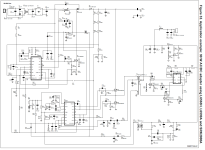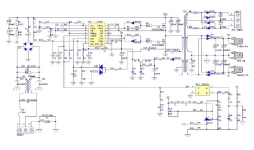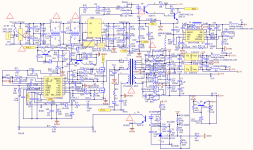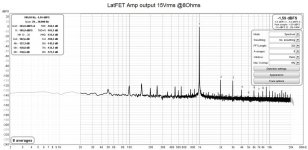Hello all!
I have found a few schematics based on L6599AD chip.
I am wondering if there is simulation model available and how to simulate SMPS.
I then want to create schematics and PCB layout for few different power outputs and post them for everyone to access.
Any help is appreciated.
I have found a few schematics based on L6599AD chip.
I am wondering if there is simulation model available and how to simulate SMPS.
I then want to create schematics and PCB layout for few different power outputs and post them for everyone to access.
Any help is appreciated.
Attachments
Audio quality ... ?
A stable power supply is a stable power supply.
A stable power supply is a stable power supply.
Yes of course there are performance numbers.
So low noise, yes, good regulation (which is also again ambiguous), silent (no fan?), low EMI compared to LED also ambiguous.
You could give some numbers like Zout < 0.5ohms (good regulation), noise < 10mV, no fan, low EMI I don't know what the number should be.
Jan
So low noise, yes, good regulation (which is also again ambiguous), silent (no fan?), low EMI compared to LED also ambiguous.
You could give some numbers like Zout < 0.5ohms (good regulation), noise < 10mV, no fan, low EMI I don't know what the number should be.
Jan
I can give a use case - I want to use it with Modulus 86 two channel amplifier.
Input voltage 115V
Output voltage 30V
Output current 40mA to 15A
Amp can get thd+n in order of 0.0001%
Power supply needs to be low noise to allow for that thd+n
Input voltage 115V
Output voltage 30V
Output current 40mA to 15A
Amp can get thd+n in order of 0.0001%
Power supply needs to be low noise to allow for that thd+n
What specific value do you want to achieve?Power supply needs to be low noise to allow for that thd+n
Having 50mVp-p 100Hz ripple in LLC is already very good, having 150mVp-p ripple at 100Hz is usually the norm in LLC. But with thd under sinusoidal load everything is much worse in them.
Hi. L6599 is a LLC controller, so it can't do pwm regulation, just control frequency. Have one psu with it, and without load it works on max frequency, and voltage exceeds the normal one. So regulation is poor i would say. It will need some load, maybe 10-20 percent of full output power, to get into regulation .LLC psu are very popular in lcd TV's, because regardless of led or lamps brightness modulation, there are still other loads. So for such psu to come into regulation got audio amplifier as possible solution would be adjust amplifiers idle current to some hot point and use larger heatsink. Also have read document about comparing smps topologies ,and it lists LLC not as best regulation. Maybe another controller chip with skip cycle option would be more suitable, but it may introduce other issues. Also same problem as always may be introduced, feedback oscillates if larger capacitive load is added ,like capacitor bank. Maybe big inductor behind capacitor bank would solve that.
According to Bob Cordell:
An LLC converter that is preceded by active PFC and using primary-side regulation (flux regulation) appears to be an attractive choice. It is highly desirable that the isolated LLC be able to have quick response time and the ability to provide high peak current. The addition of a loading converter may enhance the ability of the system to deal with the very wide range of load current encountered in an audio power amplifier.
It seems to me that I will need to utilize at least two ICs:
L6563H - PFC controller
L6599A - LLC resonant controller
An LLC converter that is preceded by active PFC and using primary-side regulation (flux regulation) appears to be an attractive choice. It is highly desirable that the isolated LLC be able to have quick response time and the ability to provide high peak current. The addition of a loading converter may enhance the ability of the system to deal with the very wide range of load current encountered in an audio power amplifier.
It seems to me that I will need to utilize at least two ICs:
L6563H - PFC controller
L6599A - LLC resonant controller
Last edited:
This is exactly the approach used in serial LLCs. The only question is, can you make it cheaper and better than a serial product?An LLC converter that is preceded by active PFC and using primary-side regulation (flux regulation) appears to be an attractive choice.
https://www.aliexpress.com/item/100...eOtherSeller|query_from:&gatewayAdapt=glo2vnm
I am confident that there is a way to make better SMPS for audio amplifier.
Cost is not a consideration, as long as it is within sensible range. I don’t want to cheap out on components and get something that underperforms. As they say, you get what you pay for.
Cost is not a consideration, as long as it is within sensible range. I don’t want to cheap out on components and get something that underperforms. As they say, you get what you pay for.
C'mon Jan. You know the answer to this. An audio quality power supply is one hand carved from Unobtainium and solid BS by virgins. 🙂Yes, that would also be my question. What's an audio quality power supply??
Jan
Or you get what you design for. The current transient loading for example. What's realistic? You'd have to measure what the amplifier wants for conditions, like theoretical worst case and worst case from the most demanding music you know of. Then pick a reasonable design target - just for transient current.As they say, you get what you pay for.
I remember the vendors supplying us when I worked in the CPU chip industry would remark they could sell us a cheaper converter, if we didnt have such ridiculous transient current requirements. The problem was, no one knew what the actual practical current transient was and the only way to come close for measurement was to use some deliberately written 'virus' machine code, something a compiler would never do. But, since no one knew what sequence of instruction a compiler could spit out, nor if it was possible to hit worst case, they had to cover it.
Likewise for an audio power supply. Does a 0 - 100W, square-modulated 20 kHz bursts 50 times a second generate a realistic supply transient current requirement? Does the 1812 Overture? What if the next musical piece you didnt know existed gets played at high volume and breaks the design's capability? The right value is a compromise between your best guess for worst case and ordinary listening.
I was able to find this elaborate application note that also has LTSpice simulation for LLC converter. Way over my head which means time to study 🤷🏻♂️
https://www.infineon.com/dgdl/Infin...N.pdf?fileId=8ac78c8c86919021018713adb87d42e2
https://www.infineon.com/dgdl/Infin...N.pdf?fileId=8ac78c8c86919021018713adb87d42e2
LLC-converter with PFC pre-regulator would be my choice. Even the unregulated LLC converter offers overload characteristics similar to linear transformer supplies.
Did some design with these and experienced LL6599 prone to unexpected burning.
After all I recommend ON-semi LLC1396 controller.
Btw, class-AB amps worked fine for decades with unregulated transformer supplies with a focus on high power supply rejection designs eliminating supply noise.
Did some design with these and experienced LL6599 prone to unexpected burning.
After all I recommend ON-semi LLC1396 controller.
Btw, class-AB amps worked fine for decades with unregulated transformer supplies with a focus on high power supply rejection designs eliminating supply noise.
I found these:
NCP1397 - Resonant Controller with Integrated High Voltage Drivers
NCP1654 - Continuous Conduction Mode (CCM) Power Factor Correction Controller
NCP1397 - Resonant Controller with Integrated High Voltage Drivers
NCP1654 - Continuous Conduction Mode (CCM) Power Factor Correction Controller
Regarding unregulated linear power supplies - I don’t have anything against them, I am just surprised that there is no good SMPS available there for audio diy community to use 🤷🏻♂️
- Home
- Amplifiers
- Power Supplies
- Has anybody tried designing audio quality SMPS based on L6599AD?



